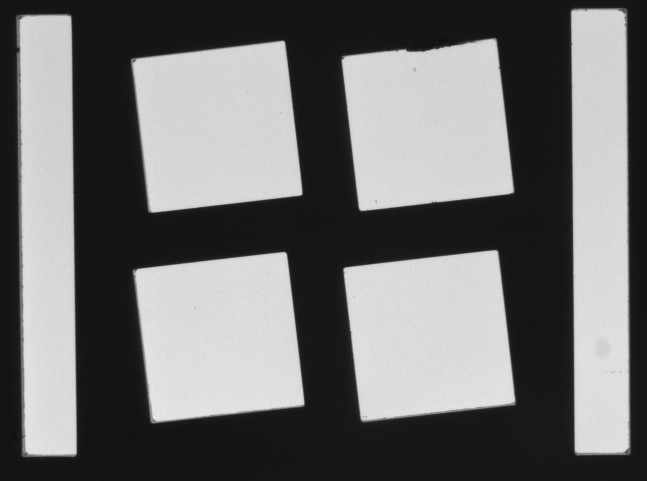* This example program shows how fit_rectangle2_contour_xld can be used to
* detect manufacturing errors of punched holes in a metal part. The errors
* show up as small protrusions of the metal into the hole. They can be detected
* by fitting rectangles to the edges of the hole robustly (i.e., with outlier
* suppression) and the calculating the distances of the edges to the rectangle
* sides using dist_rectangle2_contour_points_xld. Since the corners of the
* holes are slightly rounded, some extra processing must be performed to
* disregard the corners in the check for errors.
dev_update_off ()
read_image (Image, 'punched_holes')
get_image_size (Image, Width, Height)
dev_close_window ()
dev_open_window (0, 0, Width, Height, 'black', WindowHandle)
set_display_font (WindowHandle, 16, 'mono', 'true', 'false')
dev_display (Image)
* Since the metal part is backlit, the processing speed can be increased
* significantly by constructing a ROI for the subpixel-precise edge extraction
* that is as small as possible. This can easily be achieved by thresholding and
* morphology.
fast_threshold (Image, Region, 128, 255, 10)
boundary (Region, Border, 'inner')
dilation_rectangle1 (Border, EdgeROI, 7, 7)
reduce_domain (Image, EdgeROI, ImageReduced)
* Perform the edge extraction.
edges_sub_pix (ImageReduced, Edges, 'canny', 1.7, 40, 120)
* Remove edge fragments that are too short.
select_shape_xld (Edges, RectangleEdges, 'contlength', 'and', 500, 100000)
* Fit rectangles to the holes' edges using the outlier suppression of Tukey.
fit_rectangle2_contour_xld (RectangleEdges, 'tukey', -1, 0, 0, 3, 2, Row, Column, Phi, Length1, Length2, PointOrder)
* Create rectangles with the fitted parameters for visualization purposes.
gen_rectangle2_contour_xld (Rectangles, Row, Column, Phi, Length1, Length2)
dev_set_color ('yellow')
dev_display (Rectangles)
* Check whether the holes are OK.
count_obj (RectangleEdges, Number)
for I := 0 to Number - 1 by 1
select_obj (RectangleEdges, RectangleEdge, I + 1)
* Get the contour's coordinates.
get_contour_xld (RectangleEdge, Rows, Cols)
* Create a rectangle with the appropriate rectangle parameters.
gen_rectangle2_contour_xld (Rect, Row[I], Column[I], Phi[I], Length1[I], Length2[I])
* Get the coordinates of the rectangle's corners.
get_contour_xld (Rect, RowC, ColC)
* Calculate the distances of all the contour points to the four corners of the
* rectangle.
*计算轮廓上的每一点到4个拟合顶点的数据,形成4组数据
D1 := sqrt((Rows - RowC[0]) * (Rows - RowC[0]) + (Cols - ColC[0]) * (Cols - ColC[0]))
D2 := sqrt((Rows - RowC[1]) * (Rows - RowC[1]) + (Cols - ColC[1]) * (Cols - ColC[1]))
D3 := sqrt((Rows - RowC[2]) * (Rows - RowC[2]) + (Cols - ColC[2]) * (Cols - ColC[2]))
D4 := sqrt((Rows - RowC[3]) * (Rows - RowC[3]) + (Cols - ColC[3]) * (Cols - ColC[3]))
* The distance of the contour points to the corners of the rectangle is given
* by the minimum of the four distances. This distance is used to exclude
* contour points that are too close to the corners from the check for errors.
*min2 演示
*t1:=[1 ,5 , 10, 15]
*t2:=[2, 6 , 9, 20]
*t3:=min2(t1,t2)
DistCorner := min2(min2(D1,D2),min2(D3,D4))
*DistCorner里面存放的是冲洞轮廓线上的每一点到4个顶点(指拟合矩形4个顶点)的距离,
*把DistCorner数组分成12段,第1段跟第12段里面存放的是轮廓第一个转角上的那些点到第一个顶点的距离,
*第2段是紧接着的直线段上面的点到线段上2个顶点上那个距离最短的那些距离。
* Calculate the distances of the contour points of the rectangle.
dist_rectangle2_contour_points_xld (RectangleEdge, 0, Row[I], Column[I], Phi[I], Length1[I], Length2[I], Dist)
* Check whether the hole is OK by examining the distances of the contour
* points to the rectangle. A hole is OK if all points that lie more than seven
* pixels from the corners have a distance of less than one pixel to the fitted
* rectangle. To do so, we could use the following code:
* RectangleOK := true
* for J := 0 to |Dist| - 1 by 1
* if (DistCorner[J] > 7.0 and Dist[J] > 1.0)
* RectangleOK := false
* break
* endif
* endfor
* A much faster way to do this in HDevelop is to generate a mask that
* contains 0 for all points that should not be taken into account and 1
* otherwise. To do so, we subtract the minimum distance of 7.0 from the
* distances to the corners and take the maximum of 0.0 and the resulting
* values. This sets all the distances that are too close to the corners to 0.
* To set all other values to 1, we can simply take the sign of the values.
*max2 演示
*t:=[1,3,6,7,8]
*t1:=max2(t,5)
*t2:=sgn([-3,-1.5,0,1,3])
Mask := sgn(max2(DistCorner - 7.0,0.0))
* We can now multiply the distances to the rectangle with the mask and
* check whether the maximum distance is smaller than the maximum allowed
* distance of 1.0.
*mask作用是屏蔽掉4个转角的数据
RectangleOK := max(Dist * Mask) <= 1.0
* Display whether the hole is OK.
if (RectangleOK)
dev_set_color ('green')
get_string_extents (WindowHandle, 'OK', Ascent, Descent, Width, Height)
set_tposition (WindowHandle, Row[I] - Height / 2, Column[I] - Width / 2)
write_string (WindowHandle, 'OK')
else
dev_set_color ('red')
get_string_extents (WindowHandle, 'Not OK', Ascent, Descent, Width, Height)
set_tposition (WindowHandle, Row[I] - Height / 2, Column[I] - Width / 2)
write_string (WindowHandle, 'Not OK')
endif
endfor









【推荐】国内首个AI IDE,深度理解中文开发场景,立即下载体验Trae
【推荐】编程新体验,更懂你的AI,立即体验豆包MarsCode编程助手
【推荐】抖音旗下AI助手豆包,你的智能百科全书,全免费不限次数
【推荐】轻量又高性能的 SSH 工具 IShell:AI 加持,快人一步
· 如何编写易于单元测试的代码
· 10年+ .NET Coder 心语,封装的思维:从隐藏、稳定开始理解其本质意义
· .NET Core 中如何实现缓存的预热?
· 从 HTTP 原因短语缺失研究 HTTP/2 和 HTTP/3 的设计差异
· AI与.NET技术实操系列:向量存储与相似性搜索在 .NET 中的实现
· 周边上新:园子的第一款马克杯温暖上架
· Open-Sora 2.0 重磅开源!
· .NET周刊【3月第1期 2025-03-02】
· [AI/GPT/综述] AI Agent的设计模式综述
· 分享 3 个 .NET 开源的文件压缩处理库,助力快速实现文件压缩解压功能!
2016-08-18 动能公式推导